
NatureServe, Inc. is a non-profit organization based in Arlington County, Virginia, US that provides proprietary wildlife conservation-related data, tools, and services to private and government clients, partner organizations, and the public. NatureServe reports being "headquartered in Arlington, Virginia, with regional offices in four U.S. locations and in Canada." In calendar year 2011 they reported having 86 employees, 6 volunteers, and 15 independent officers.
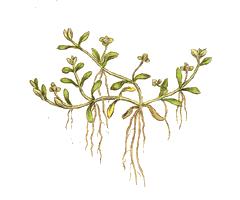
Elatinaceae is a family of flowering plants with ca 35 species in two genera: Elatine and Bergia. The Elatine are mostly aquatic herbs, and the Bergia are subshrubs to shrubs. Elatine species are widely distributed throughout the world from temperate to tropical zones, with its greatest diversity found in temperate zones. Bergia is found in temperate to tropical Eurasia and Africa, with two tropical and one tropical to temperate species in the Americas. The center for biodiversity of Bergia is the Old World tropics, and this is also the center for biodiversity for the family. Neither genus is found in arctic ecosystems.
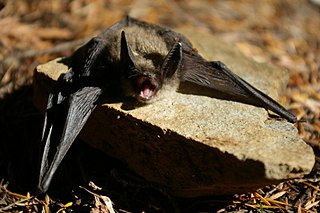
Keen's myotis is a species of vesper bat. It is found in British Columbia in Canada and in Washington and Alaska in the United States. It is named after the Rev. John Henry Keen, who collected the specimen that formed the basis for the first scientific description of the species. Classification for Keen's myotis formerly included the Northern long-eared Myotis, resulting in older studies confusing the species for one another.

Elatine is one of only two genera in the plant family Elatinaceae, the waterwort family. It contains about 25 species of aquatic plants known generally as waterworts. These are annual or perennial plants found in wet areas worldwide.
Phyllostegia glabra is a species of flowering plant in the mint family known by the common name smooth phyllostegia. It is endemic to Hawaii.

Braya pilosa is a long-lived perennial flowering plant of the mustard family known by the common name hairy braya. It has one to many stems 4–12 cm long, erect to ascending to almost prostrate and moderately to densely hairy, and can be distinguished from other Braya species by its large flowers and globose fruits with very long styles. The plant arises from a tuft of basal leaves, with white flowers arranged in dense clusters. Its range is limited to the unglaciated portions of Cape Bathurst and Baillie Islands on the shore of the Beaufort Sea in the Northwest Territories, and it is listed at G2 - imperiled by NatureServe and endangered by the Committee on the Status of Endangered Wildlife in Canada (COSEWIC). Its chief threats are loss of habitat through rapid coastal erosion and saline wash from storm surges, and by melting permafrost.
Wijkia carlottae, or Carlott's wijkia moss, is a species of moss of the family Pylaisiadelphaceae and genus Wijkia. It is endemic to the Haida Gwaii archipelago in British Columbia, Canada. It occurs in a number of different habitats, but only 10 occurrences are known. It is possibly threatened by logging and it currently classified as vulnerable by NatureServe.

Elatine hydropiper is a species of flowering plant belonging to the family Elatinaceae.
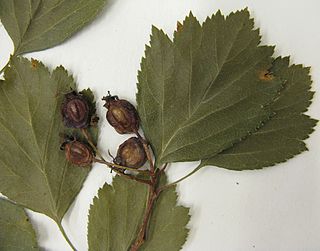
Crataegus purpurella, also known as the Loch Lomond hawthorn, is a plant in the Crataegus genus. It is endemic to Saskatchewan, Canada, and is unranked by NatureServe.
Salix turnorii, also known as Turnor's willow, is a species of willow. It is endemic to the Athabasca Sand Dunes Provincial Park in Saskatchewan, Canada. It is listed as imperiled by NatureServe.
Nestotus macleanii, also known as the Yukon goldenweed, is a species of plant in the genus nestotus. It is endemic to the Yukon, Canada. According to NatureServe, it is vulnerable but not currently at risk.
Salix chlorolepis, also known as the green-scaled willow, is a species of willow. It is endemic to Mount Albert and its surroundings in Quebec, Canada. It is listed as critically imperiled by NatureServe.
Draba kluanei, also known as Kluane draba, is a species of plant in the Draba genus. It is endemic to the Kluane National Park in the Yukon, Canada. It is listed as possibly extinct by NatureServe.
Draba yukonensis, also known as the Yukon draba or the Yukon whitlow-grass, is a species of plant of the Draba genus. It is endemic to the Yukon, Canada. It is listed as imperiled by NatureServe.
Draba caswellii, also known as Caswell's draba, is a species of plant of the Draba genus. It is endemic to the Kluane National Park in the Yukon, Canada. It is listed as critically imperiled by NatureServe.
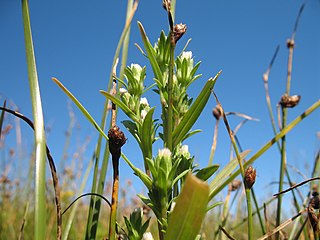
Symphyotrichum laurentianum is a critically imperiled species of flowering plant in the family Asteraceae endemic to the southern shores of the Gulf of St. Lawrence in Canada. Commonly known as Gulf of St. Lawrence aster, it is an annual, herbaceous plant with one stem and no ray florets that grows up to about 13 centimetres tall.

Symphyotrichum yukonense is a species of flowering plant in the family Asteraceae endemic to disjunct areas in Alaska and the Canadian territories of Yukon and Northwest Territories. Commonly known as Yukon aster, it is a perennial, herbaceous plant 5 to 30 centimetres tall. Its flowers have purple to blue ray florets and yellow to brown disk florets. S. yukonense grows at elevations of 300–1,500 metres in mud flats and on sandy or silty lake shores. It is a NatureServe Vulnerable (G3) species and is classified Imperiled (S2) in its Canadian range.

Symphyotrichum nahanniense is a species of flowering plant in the family Asteraceae endemic to Northwest Territories, Canada. Commonly known as Nahanni aster, it is a perennial, herbaceous plant that grows about 7 to 39 centimetres in height. Its flowers have white to pale rose, often becoming rose-violet, ray florets and yellow then reddish disk florets.
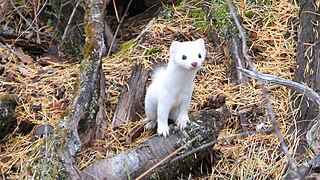
The Haida ermine is a mustelid species endemic to a few islands off the Pacific Northwest of North America, namely Haida Gwaii in Canada and the southern Alexander Archipelago in the U.S. state of Alaska.
Elatine gussonei is a species of plant in the genus Elatine (waterworts). It is endemic to Malta.









